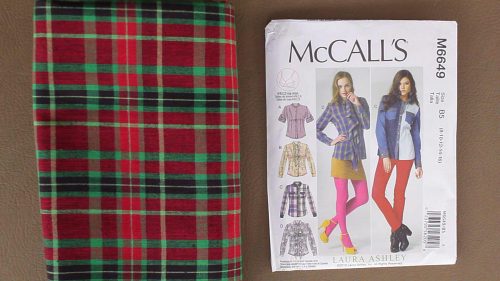 One would think that a fabric printed with nothing but straight lines, such as plaids or stripes, would be easier to work with than a design that's going all over the place. Surprisingly, the opposite is actually true. For beginners, it's better to stick with prints that would be considered non-directional. This means that no matter which way you look at the print, there's no clear direction. As a result, there's a little more flexibility when sewing your pieces together and less of an expectation that you need to match the design from piece to piece. With a directional design, such as plaid or stripes, lines going across your garment should match in order to look more seamless and pleasing to the eye. Because of this, more thought has to go into working with a directional fabric, from figuring out the type of fabric to laying out your pattern pieces. For our demonstration, we use McCall's 6649, because plaid and buttoned down shirts, go together like peanut butter and jelly.
One would think that a fabric printed with nothing but straight lines, such as plaids or stripes, would be easier to work with than a design that's going all over the place. Surprisingly, the opposite is actually true. For beginners, it's better to stick with prints that would be considered non-directional. This means that no matter which way you look at the print, there's no clear direction. As a result, there's a little more flexibility when sewing your pieces together and less of an expectation that you need to match the design from piece to piece. With a directional design, such as plaid or stripes, lines going across your garment should match in order to look more seamless and pleasing to the eye. Because of this, more thought has to go into working with a directional fabric, from figuring out the type of fabric to laying out your pattern pieces. For our demonstration, we use McCall's 6649, because plaid and buttoned down shirts, go together like peanut butter and jelly.
Since you are matching the fabric together in a specific way, it's typical that you have to purchase more fabric than what is recommended on the back of the pattern envelope. You'll notice sometimes with inexpensive, ready to wear garments, that their design lines will not necessarily match. They, of course, are more worried about the bottom line and saving fabric then matching their plaids perfectly. Matching plaids will waste fabric but, as a result, your garment will have a cleaner design and look.
Lastly, we go over some tricks on sewing plaid. After spending a lot of prep time lining up our pieces perfectly, one doesn't want it all to go awry at the sewing process. If all this makes you think that sewing with plaid is a scary process, then consider starting with a simple stripe or checkered design and a pattern with few seams, just to get your feet wet. You'll see that if you do the proper prepwork and take your time, it's really not so hard.

